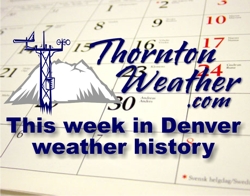
If history is a teacher, our look back at this week in Denver weather history should provide great instruction on the dangers severe weather presents in our history. It was three years ago this week that the infamous Windsor tornado tore through the area killing one man and damaging hundreds of homes.
From the National Weather Service:
20-22
In 1959…a three-day rain caused some flooding in metro Denver where rain totaled 1.68 inches at Stapleton Airport. Showers…accompanied by hail near Brighton…caused some damage to truck crops. Heavy snow in the foothills caused damage to power and telephone lines.
20-27
In 2002…lightning sparked a wildfire near Deckers. Extremely dry conditions and very strong winds the following day allowed the fire…known as the schoonover…to consume 3850 acres before it could be contained. Thirteen structures were destroyed…including 4 homes…resulting in 2.2 million dollars in damage.
21-22
In 1878…overnight heavy rains of cloudburst intensity on the Palmer Divide to the south of the city caused flash flooding on Cherry Creek in Denver…which resulted in 2 deaths. A wall of water swept through the city between 2:00 am and 3:00 am on the morning of the 22nd. The flood was so sudden and unexpected that homes along the creek in the city were submerged in water knee deep before the slumbering occupants knew anything about it. By daybreak the banks on both sides of the creek were lined by residents viewing the destruction caused by the raging waters in such a short time. Seven bridges across the creek were destroyed in the city. Damage to private and city property was estimated between 30 and 50 thousand dollars. Quite a number of cattle and sheep were killed along the reach of the creek. Only 0.01 inch of rain fell in the city on the 21st with a trace of rain on the 22nd. Flash flooding also occurred on Kiowa Creek near Bennett on the night of the 21st when the flood waters washed out the Kansas Pacific Railroad bridge. An east bound freight train plunged into the turbulent waters killing the three crewmen. The locomotive was completely buried in the sand and never found to this day!
21-23
In 1876…snow changed to heavy rain over the city…resulting in widespread flooding along Cherry Creek and the South Platte River…nearly as great as the flash flood of May 19-20…1864. However…damage was greater because the city had grown much larger and there were more bridges for the flood waters to destroy. Precipitation in the city totaled 6.70 inches from 10:00 pm on the 21st through 3:00 am on the 23rd. The greatest precipitation ever recorded in Denver in 24 hours…6.53 inches…occurred on the 21st and 22nd. Small buildings and bridges along Cherry Creek were washed away by the flood waters. Bridges over the South Platte River were damaged. The city irrigation ditch was damaged and rendered unfit for service. Strong winds at speeds of 30 to 40 mph drove the heavy rain through brick walls 12 to 16 inches thick. Many sheep and cattle were either killed by lightning or drowned…including some 100 head of cattle in Jefferson County alone. There was immense damage to railroad tracks…especially the Kansas Pacific line to the east of the city. The Colorado central suffered estimated damage of 10 to 15 thousand dollars. In addition…the heavy rain caused extensive flooding on soda and bear creeks in the foothills. Flooding along Boulder creek inundated farm and pasture land in the Boulder valley and damaged a few bridges. Rail travel had to be suspended in the area for several days.
Continue reading May 22 to May 28 – This Week in Denver Weather History

